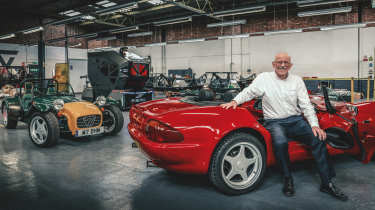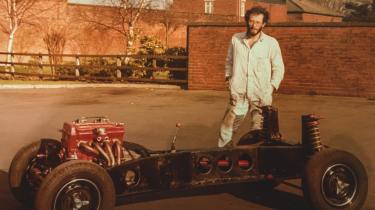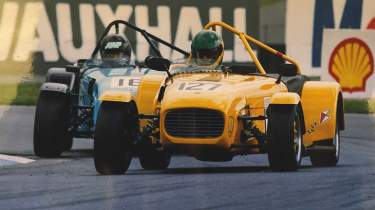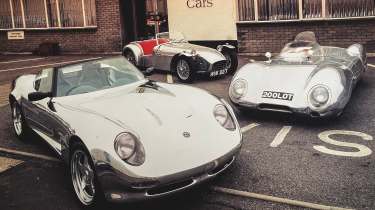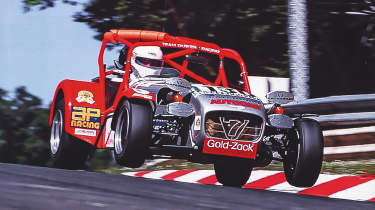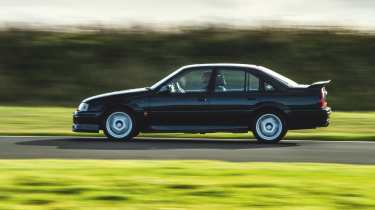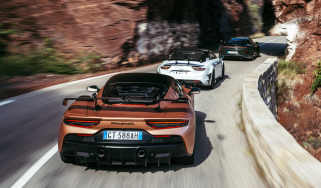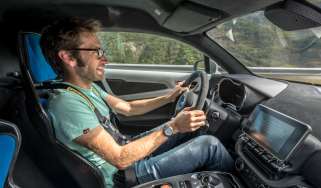My Life & Cars – Jez Coates, ex-Caterham technical director and vehicle engineer
Having helped the Caterham Seven survive and thrive for over 20 years, Jez Coates now works with a very different kind of vehicle. Here he discusses his roles past and present, and his enviable car history
For many years, Caterham Cars was based on a modest industrial estate at Kennet Road, Dartford, and we’d go there to meet technical director Jez Coates and go for a blast in the latest version of the Seven that he and his team had created. Today we’ve driven to a modest industrial estate on the outskirts of Coventry to meet Coates, but while the setting has a familiar feel, the company he now works for is rather different. Aurrigo is, among other things, an emerging force in the autonomous EV market and Coates, the firm’s chief engineer, runs a Tesla Model 3. That seems a long way from the lightweight, whipcrack Seven, but the skill set that Coates honed in his 23 years at Caterham matches the requirements of this part of the company remarkably well.
Coates, now 67, was brought up in the small market town of Kirkby Stephen, Cumbria. ‘I’ve always been into cars,’ he says. ‘I remember when I was six or seven on holiday with my parents being driven around Rome seeing how many Fiat 500s I could count before I saw another car.’ His first taste of driving came in an Austin A35 that had belonged to his grandmother and then his brother. ‘It failed its MOT so he discarded it. I patched up the rust holes with body filler and chicken wire and learned to drive. I’d have been 15 or 16. We had a bit of a driveway, about 100 yards long, so I could get up to third gear and then throw on the anchors. Brakes is a rather optimistic word to use with regard to the A35. I rolled that 17 days after my 17th birthday. I think I was 25 before I owned a car that I didn’t roll…’
> My Life & Cars – Mike Conway, Le Mans winner and WEC champion
Like many teenagers, Coates wasn’t sure what he wanted to do. ‘One day I had an epiphany. I thought: somebody’s got to design cars and I’m fascinated by cars. So I applied for a job at JRT [Jaguar Rover Triumph], a sponsorship. The letter I got back was like opening a Howler from Harry Potter.’ After berating him for the lateness of his application it suggested he try Leyland Trucks, down the road in Lancashire. He did and found himself quickly accepted and in receipt of a decent grant, which he quickly converted into a Lotus Elan S3 and, almost as quickly, into a £1400 overdraft.
In the ’70s Leyland Trucks was still a vast and significant company and the scope of the training Coates got there on breaks from uni was fantastic. ‘Every two weeks you’d do a different department, so the breadth and depth of understanding of how an engineering organisation works was just brilliant.’
Coates eventually found himself working in the test operations department. This took him to some far-flung places but the most memorable experience was working with London Transport on a replacement for the iconic Routemaster bus. ‘The management got exasperated with London Transport in terms of what they wanted,’ he recalls, ‘They’d say, “We want it to be just like a Routemaster, but not a Routemaster.” Eventually, Leyland said: “Well, if this bloody Routemaster is so fantastic, send one up and we’ll put it through a full set of tests.” So this antique bus turns up and I get the job of testing it. And, of course, it’s bloody fantastic: brilliantly engineered, beautifully made and really fit for purpose. So I’m a Routemaster fan.’
Although he owned a ’67 Elan, Coates really wanted the ’73 version and so started buying bits from ads in Motoring News. Somehow he ended up with a couple of big-valve heads and put one up for sale, which prompted a call from David Wakefield at Caterham Cars. A deal was struck and Coates offered to drop it in because his girlfriend lived in Maidstone. ‘It’s funny how these things happen, isn’t it?’ he says.
Caterham was hungry for twin-cam cylinder heads because very soon after Graham Nearn had acquired the rights to the Seven from Colin Chapman, Lotus lost the tooling for the twin-cam head. At this time, 1983, Caterham was building about 80 cars a year, most for Japan, and they wanted the twin-cam engine. Delivering the head, Coates plucked up the courage to say, ‘If you’re looking for a keen young graduate, give me a shout.’ The phone rang the next day and so Coates moved from Leyland Trucks in Leyland, Lancs, to Caterham Cars in Caterham, Surrey. ‘I was employee number 14,’ he recalls. ‘Unofficial title: general management dogsbody.’
An early shift in the business was prompted by a rival, Westfield Sportscars. ‘They gave us a massive kick up the arse when they went into selling the Seven in kit form because there was a huge market for it. We had to react, so I masterminded how we did it, built a bill of materials and generated part numbers for everything. Until then we didn’t have part numbers. Or a computer. We got up to 761 kits in a year before settling down to about 480 a year.’
It was getting ever harder to buy the bits that the Seven had been inherited with, so Caterham had to start re-engineering it to keep it going. The Ford live axle died, was replaced by the axle from the Morris Ital, and then that died too. ‘We had a meeting down the pub and decided to do a de Dion axle because some very early Sevens were de Dion. It was also less complicated than fully independent – a man’s got to know his limitations etcetera…
‘We got better at keeping the car in production and moved on to thinking: we could do this, we could do that… Being very commercially minded, I understood how Graham ticked. I’d say, “We want to do this and it’ll pay back in less than a year.” So we’d do things like our own wheels; tooling’s not massively expensive but you can sell them for a big premium because it’s bespoke and lighter than anything else.’
One-make racing proved to be a significant part of the business, yet it started in a rather off-hand way. ‘There was a Colin Chapman Memorial race at Brands Hatch in ’83 and Graham said, “We need to go for this.” There were 12 cars on the grid; I think we owned eight of them – we’d all got race licences. That was the start. Then we put some race regs together and ran three classes for BDAs, twin-cams or crossflows in various states of tune, and that began to get some traction.’
What really helped the racing take off was ‘The Alex Hawkridge Experience’. Hawkridge was a seriously well-funded individual who interpreted every rule to his advantage. ‘He absolutely cleaned up in Class A and completely pissed off everyone else. We’d had 17 cars in Class A; the following season, we had four.’ Coates created a strict, watertight (affectionately known as the ‘whips and bondage’) set of regulations to ensure it was driver versus driver and It promoted such great racing that Seven championships sprang up around the world.
In the early ’90s the venerable but pensionable Ford Kent engine was joined by more modern units from Vauxhall and Rover, which led to a bunch of new models including the HPC and the JPE – the Jonathan Palmer Evolution, powered by a 250bhp Vauxhall ‘red top’. ‘I absolutely loved creating new versions of the car but I never lost sight of the fact that you needed to do the grungy stuff as well. We were always trying to make the car easier to build with less tools and less people. We got to the point where only six guys in the factory built 480 cars a year.’
Then came the 21. ‘We had confidence that we could deliver things, and Graham was always worried that the Seven would be legislated out of existence or that customers would suddenly realise that this funny little car was noisy and uncomfortable.’ Certainly, the automotive world was advancing inexorably, as evidenced by Coates’ company cars. ‘I shouldn’t say it but, God, I’ve got good taste in company cars. Dave Wakefield was very Ford orientated so my first was an XR3i. Dreadful car.’ This was followed by a Peugeot 205 GTI (‘lovely car, so capable’), an Esprit Turbo (‘really disappointing; toasted your luggage, massive turbo lag’), an Integrale (‘lovely drivetrain but left-hand drive’) and, incredibly, a Lotus Carlton.
‘Vauxhall wanted all the Caterham senior team in Vauxhalls and I managed to get a Lotus Carlton, L212 MAU. It was very, very good value for money and much loved. I got to 120,000 miles and it ran out of second-gear synchro. You couldn’t buy parts, a new gearbox was £7k, so we flogged it for £13k. Then I had an E34 M5, six-speeder with Nürburgring suspension, which was its downfall; we kept having to replace leaky dampers. So I moved on to an E39 M5. I’ve still got one.
‘The idea with the 21 was to build a Caterham that looked like a proper grown-up car, that had more practicality. However, I got carried away; I was too protective of it, doing it in my barn at home with Iain Robertson, our in-house Royal College of Art-qualified designer. Eventually we went “Ta-da!” and gave it to sales and they said, “Well, it’s more difficult to get into than a Seven and the windows don’t go up and down.” I’m still very proud of the 21 but I made some mistakes, and then Lotus launched the fantastic Elise. Game over. The engineering of the Elise doors cost more the entire 21 project. So close but no cigar.’
The bounce-back car was the Superlight. ‘This time we brought the whole company with us. We held a meeting, invited all the staff, told them what we planned to do and invited suggestions. Superlight took the Seven all the way back to Chapman – “add lightness” – and led to the R500, R400 and R300. Possibly our finest hour. The R500 is the same weight as a Series One but it’s got six times the power and 50 per cent more gears.’
Coates still had a desire to make a more useable Seven, ‘a more forgiving and capable version for the less talented’, and managed to broker a deal with Multimatic to make an independent-suspension car, the CSR. ‘They did it for almost nothing and must have spent a fortune, but they got very good coverage in evo and I genuinely feel it was one of the things that elevated their status. From an engineering point of view, it was very, very satisfying.’
However, in 2005, before the CSR was ready for production, the Nearns sold Caterham to a venture capitalist company. ‘VCs have their own rules of engagement. Once I’d been pumped for knowledge I got invited to leave. It obviously rocked my confidence. I didn’t want to work for TVR or Ginetta and couldn’t see my skill set fitting Aston Martin or JLR, so I bumbled around until I met Nic Strong and did the Zolfe Orange. Okay, it’s another commercial failure – the recession took us down – but we built about ten cars and I enjoyed it.
‘Then at a Niche Vehicle Network meeting I got talking to Dave Keane from Aurrigo, a supplier to Caterham, and he said, “I’m about to win a project. I need somebody to run it. Would you like a job?” The traditional side of the business is making wiring looms but in 2013, when I joined as chief engineer, the owners decided to build the capability to engineer whole vehicles and we’ve won a number of contracts to build and deploy autonomous vehicles. There’s been an explosion in start-up companies trying to bring new product and a hell of a lot of them can’t work out how to make anything. We’ve done ten vehicles in ten years. Ten years ago, I thought I didn’t have a useful skill set, now I’m tempted to think I’ve got a unique skill set.’
A big chunk of Coates’ day job is EV-related but back at home he has a tasty collection of ICE cars. As well as the E39 M5 he has an E46 M3, a Lotus Elan Sprint 5, an Aston Martin Vantage V12 S seven-speed manual and a couple of special Caterhams. ‘I’ve got a unique CSR with a 250bhp, R500 Evo K-series engine rather than the “boat anchor” – sorry, the standard Ford Duratec – and I’m currently trying to massage the Zolfe’s Mazda drivetrain underneath the last-ever 21.’ You can take the man out of Caterham…
This story was first featured in evo issue 319.

